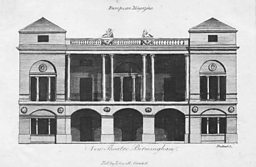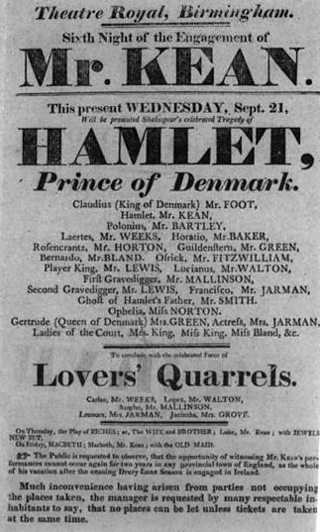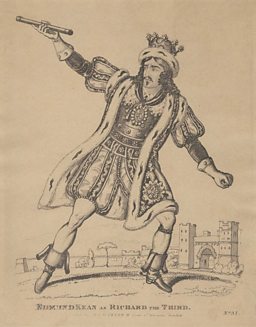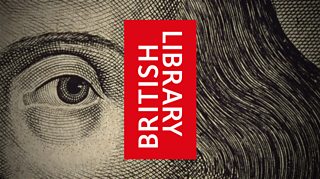Star Shakespearean actor puts Birmingham on the theatre map
Birmingham’s Theatre Royal opened in 1807 – a sign of great prestige and testament to the growth and importance of England’s emerging 'second city'.
This playbill from the British Library collection shows how the stars of the London Theatre stage were also coming out of the capital to play in Birmingham.
-
![]()
Much ado near me
Hear more Shakespeare stories on BBC WM 95.6
-
![]()
Shakespeare Festival 2016
The BBC celebrates the genius of the bard

This particular posting bears the name of one of the great Shakespearean actors of the time in the part of Hamlet – Edmund Kean… the Benedict Cumberbatch of his day.

Or does it? Because the playbill does not carry a year for the date, so there is a mystery to solve here. Is this Edmund Kean, the most famous actor of his time – and a major coup for Birmingham’s Theatre Royal – or is it in fact his lesser-known son Charles, who also acted in theatres outside London? The playbills from Birmingham span a period from about the 1790's to the Victorian era and chart a growing desire for audiences to see the big stars coming out of London.
They also record the development of the city during the industrial revolution, to a size where it could support a big theatre such as this.
The Theatre Royal put the city on the map as a theatre going destination alongside Stratford-upon-Avon, which in itself was growing in popularity.
The playbills also show there was a desire to celebrate Shakespeare as a dramatist, and across a wide body of his work. All the London stars are seen to come to Birmingham, including Sara Siddons, brother John Kemble, Kean and many more.

Birmingham gets its Theatre Royal
During the 18th century, as places like Birmingham began to grow larger, they began to desire a permanent playhouse.
But since the 1737 Licensing Act, theatre in general was highly regulated, and only Covent Garden and Drury Lane theatres in London were awarded special patents - making these two venues the only places in the whole country where Shakespeare could be legally performed.
Most towns were served by travelling groups of players who would perform in town halls, barns or inns – with local magistrates effectively turning a blind eye.
Then from 1768 onwards, we start to see provincial towns being issued their own respective patents through an act of parliament – allowing them to establish a Theatre Royal of their own.
Earning a patent was a sign of prestige, and granted the same rights as those which had been enjoyed by Covent Garden and Drury Lane theatres – the right to perform all drama, including Shakespeare, in as long a season as they desired.
Birmingham was the eleventh such location to be awarded a patent which saw the Theatre Royal in Birmingham opening in 1807. They followed in the footsteps of places like York, Manchester, Liverpool, Bristol, Hull and Newcastle. Only two more were to follow, in Brighton and Ramsgate.
The railway effect
The arrival of the railways around the mid-1800s brought major changes to provincial theatres like Birmingham.

For the previous 100 years, theatres outside of London had sought to emulate the production values in the capital by hiring actors temporarily and copying the sets and costumes as best they could.
But the arrival of the railway, in Birmingham’s case linking the city with the capital directly, it meant they could bring in entire productions from the capital.
Within twenty years, touring companies effectively killed of locally-produced theatre, and the acting companies which had traditionally served local audiences and theatres became extinct.
The London and Birmingham Railway (L&BR) was an early railway company in the United Kingdom from 1833 to 1846, when it became part of the London and North Western Railway (L&NWR).
The 112-mile (180 km) railway line was engineered by Robert Stephenson.
It opened in 1838 between London and Birmingham was the first intercity line to be built into London.
It is now the southern section of the West Coast Main Line.
About Shakespeare on Tour
From the moment they were written through to the present day, Shakespeare’s plays have continued to enthral and inspire audiences. They’ve been performed in venues big and small – including inns, private houses and emerging provincial theatres.

BBC English Regions is building a digital picture which tracks some of the many iconic moments across the country as we follow the ‘explosion’ in the performance of The Bard’s plays, from his own lifetime to recent times.
Drawing on fascinating new research from Records of Early English Drama (REED), plus the British Library's extensive collection of playbills, as well as expertise from De Montfort University and the Arts and Humanities Research Council, Shakespeare on Tour is a unique timeline of iconic moments of those performances, starting with his own troupe of actors, to highlights from more recent times. Listen out for stories on Shakespeare’s legacy on your BBC Local Radio station from Monday 21 March, 2016.
You never know - you might find evidence of Shakespeare’s footsteps close to home…
Craig Henderson, BBC English Regions
-
![]()
Shakespeare Lives
The nation’s greatest performing arts institutions mark 400 years since the Bard's death
Related Links
Shakespeare on Tour: Around the West Midlands
-
![]()
Garrick’s festival entertains a Birmingham audience
Famous Jubilee Shakespeare celebration comes to the second city
-
![]()
Much Ado About Nothing is Manager’s choice at Wolverhampton Theatre, 1794
'Banker' play chosen for end of the season to increase profits
Shakespeare on Tour: Around the country
-
![]()
A wealthy host attracts Shakespeare's actors to Yorkshire
Shakespeare’s King’s Men visit the Clifford family at Londesborough Hall
-
![]()
Norwich gives Shakespeare's company the cold shoulder
Shakespeare's players paid 40 shillings not to perform
-
![]()
Celebrated young actor stars as Hamlet
Child prodigy actor who took theatres by storm in 1804 stars as Hamlet in Stafford
-
![]()
Much Ado about Dracula?
Much Ado About Nothing at the London Lyceum 1883









